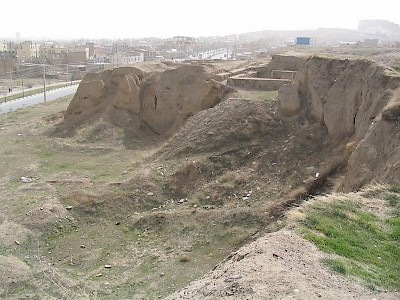Ecbatana, Palace
Palace of Cyrus in Ecbatana: semi-legendary Persian palace, one of the Seven Wonders of the Ancient World.

The palace of Cyrus the Great in Ecbatana is nothing but a name to us. Excavations in modern Hamadan have shown some buildings from the Parthian age and a couple of remains from the Achaemenid period, but so far, no traces of any building from the reign of Cyrus have come to light. Polybius states that the palace was looted by Greek conquerors:
Ecbatana had always been the royal residence of the Medes and is said to have greatly exceeded all the other cities in wealth and the magnificence of its buildings. It lies on the skirts of Mount Orontes and has no wall, but possesses an artificial citadel the fortifications of which are of wonderful strength. Beneath this stands the palace, regarding which I am in doubt whether I should go into details or keep silence. For to those who are disposed to recount marvellous tales and are in the habit of giving exaggerated and rhetorical reports of certain matters this city affords an admirable theme, but to such as approach with caution all statement which are contrary to ordinary conceptions it is a source of doubt and difficulty. The palace, however, is about seven stades in circumference, and by the magnificence of the separate structures in it conveys a high idea of the wealth of its original founders. For the woodwork was all of cedar and cypress, but no part of it was left exposed, and the rafters, the compartments of the ceiling, and the columns in the porticoes and colonnades were plated with either silver or gold, and all the tiles were silver. Most of the precious metals were stripped off in the invasion of Alexander and his Macedonians, and the rest during the reigns of Antigonus and Seleucus the son of Nicanor, but still, when Antiochus reached the place, the temple of Aene alone had the columns round it still gilded and a number of silver tiles were piled up in it, while a few gold bricks and a considerable quantity of silver ones remained. From all the objects I have mentioned sufficient was collected to coin money with the king's effigy amounting to very nearly four thousand talents.note
This may or may not be true. Excavations have, so far, not produced any results.